In which our hero fixes the ice-maker in a Samsung french door bottom-freezer refrigerator (model #RF260BEAESR) using nothing but a hair dryer and his own two dexterous hands!
So, my lovely Deborah mentions to me that she thinks the ice-maker in the refrigerator isn’t working - that the ice bucket is empty. I don’t typically use ice on a regular basis, so it isn’t something I would notice. But, when I take a look at the ice bucket, it sure does look empty-ish.
Initial Steps
First step - open up the user manual for the fridge (which, by the way, appears to be applicable for all Samsung refrigerator models that start with RF261B and RF260B) and see if it includes any tips or maintenance information for the ice-maker.
This is when downloading and saving digital (PDF) versions of user manuals proves really useful, as it allowed me to simply search the manual for “ ice” instead of having to manually scan through the whole thing.
In the user manual, I find the following:
• Did you wait for 12 hours after installation of the water supply line before making ice?
• Is the water line connected and the shut-off valve opened?
• Did you manually stop the ice making function?
• Is the freezer temperature too warm? Try setting the freezer temperature lower.
All items in the list check-out.
Second step - toggle the ice-making function off and on a couple times.
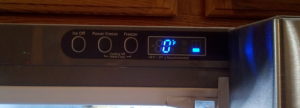
I do this, but observe no difference.
Third step - manually force the ice-maker through a test cycle (PDF). I find this tip on the web. It looks like this action forces a lazy/mis-behaving ice-maker to drop any ice cubes it contains.
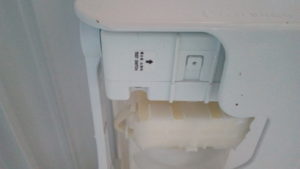
I find the button, push it, and hold it until I hear the motor in the ice-maker engage. No ice cubes drop, though.
While there, I decide to reach my hand and fingers up to feel if there is any ice or water in the tray of the ice-maker. It’s empty.
Getting Closer
Fourth step - given that the tray of the ice-maker is empty, I figure that the root issue lay somewhere in the water supply “chain". I pull the refrigerator out from the wall and inspect the water supply lines for any issues.
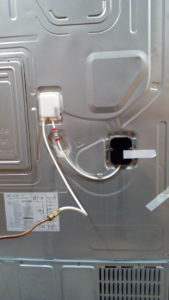
I have a flexible supply line running from the cold water pipe in my basement to the back of my fridge, right at the spot where the water filter looks to be. There is also a line running out from this spot down to the spot where the ice-maker looks to be.
I unscrew and remove the access covers protecting these two spots on the fridge, to see if there is any sort of removable or actionable mechanism. I don’t see much of anything of the sort. I pull and twist a bit at the couplings in the supply line (running from the water filter to the ice-maker), but I don’t get a sense that they are meant to be manipulated. I'm not able to tell if there is water flowing through any of these lines or not.
Fifth step - inspect the in-fridge water filter. I’ve never replaced the water filter in the nearly three years that I’ve owned the refrigerator, so I figure there is a chance it is preventing a flow of water to the ice-maker.
I’ve never seen any reason to replace the water filter simply based on the filter indicator turning red. Our water is fine enough to drink straight out of the tap. And I have little reason to believe that the filter indicator reflects actual water flow through the filter. I assume it turns red without any intelligence - simply based on the passage of time rather than usage.
I remove and take a look at the filter.
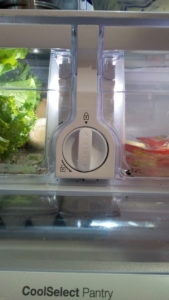
Nothing about it seems amiss. More importantly, I see a small amount of water pooled in the filter compartment, which I take as a promising sign that the water supply line is clear (at least up to the water filter). When I try to re-insert the water filter into the socket, I have a lot of difficulty. I have to push and twist the filter with a good amount of force. And even when I get it in, a steady stream of water starts leaking out.
After quickly referring to the user manual, I realize that I need to shut-off the water supply in order to re-insert the water filter. Did and done (after soaking up the spilled water).
Sixth step - check for a frozen water supply line in the freezer. This idea comes to me from the web, too. This takes some doing, as reaching around the pull-out drawer in the freezer and up to the water supply nozzle is difficult.
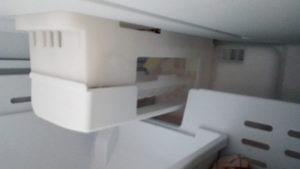
The nozzle is positioned just above the tray of the ice-maker. It is partially enclosed with a flexible rubber/silicone shroud. When I get my fingers up to it, I'm able to snap off a bit of ice that has built-up on the end of the nozzle. But, still no water flow.
Frozen Supply Line
The build-up of ice on the nozzle sure seems to me to be a sign that at least a portion of the water supply line has frozen. I find another tip on the web for un-freezing the line using a blow dryer. But, I decide to give a hand warmer a try, first. Getting a clear visual on where exactly to point a blow dryer isn’t simple. And I'm wary of over-heating and/or melting something.
I activate the hand warmer and reach into the back of the freezer to cradle the water supply nozzle in the hand warmer. Despite the awkward angle, I'm able to hold it in position for a minute or two. However, it soon becomes apparent to me that the warmer isn’t going to cut it. Blow dryer time.
I get out Deborah's blow dryer and an extension cord. In order to make the job much more feasible, I get the pull-out drawer out of the way by completely removing it from the freezer. This requires me to pull the freezer door further out on its extension rails than it typically goes, but only by a bit.
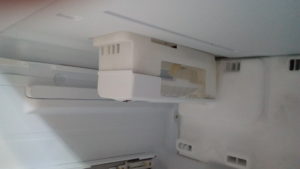
Once I have the pull-out drawer removed and off to the side, accessing the ice-maker is easier. Not easy, but easier.
In hindsight, I suppose I could have just removed the freezer drawer bin and freezer door along with the pull-out drawer. You should probably keep that in mind as an option.
I turn on the blow dryer, extend it into the back of the freezer, and point it at the frozen water supply nozzle. I can’t see what I'm doing, but it isn’t long before I notice water dripping onto the back interior wall of the freezer. That sure looks promising. I pull the blow dryer out of the freezer, re-install the pull-out drawer, and close-up the freezer.
I stand by quietly and wait expectantly for the sound of the water supply nozzle opening up to fill the tray of the ice-maker. But, all is quiet. I take a look at the control/display panel of the refrigerator and notice that the freezer temperature has risen to 8°F (0°F is normal). I surmise that the refrigerator might have some governor built-in that prevents the ice-maker from filling if the temperature is too high.
So, I step away and give the freezer some time to cool down. But, even after the freezer temperature comes back down to 0°F, no dice (or ice). I figure I’ll take another go at thawing the water supply nozzle. I repeat the steps of removing the pull-out drawer from the freezer and blowing hot air at the nozzle. I make a particular effort to point the blow dryer not just at the nozzle, but also at the furthest-back and accessible point of the in-freezer water supply line.
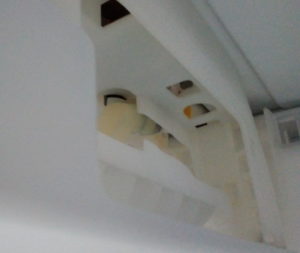
Of course, as I mentioned before, visual guidance was hard to come by. I was doing it all by touch/feel.
I watch as more water drips onto the back interior wall of the freezer. After a short period of time, the pace of dripping quickens and then I see a brief little trickle! The dripping then stops. I silently count out a few more seconds and then wrap everything up. Once again, I re-install the pull-out drawer and close-up the freezer.
I'm hoping to hear, fairly immediately, a flow of water from the nozzle, but I don’t. I walk away.
Fixed
Fortunately, it becomes apparent over the course of the ensuing day or so that the ice bucket is slowly filling up! I open up the freezer and reach my hand and fingers in and up to feel if there is any ice or water in the tray of the ice-maker - and there is! Success!
In retrospect, it made sense that a frozen supply line was the root cause. We live in the mid-Atlantic United States, and the ice-maker issue arose in mid-December. Just prior to this episode, we had been away from home for several days on a trip. While away, I had put the thermostat into vacation mode, but it went wonky (probably because the batteries ran down very low). When we got back home, the house temperature was in the mid-forties (Fahrenheit). I suppose that, with the ambient temperature being so low, it made sense that the water supply nozzle would freeze.
In the past, I’ve played around with setting my house's thermostat quite low in colder months. By “quite low”, I mean low-fifties (Fahrenheit). I had read that it isn’t a good idea to go below 55°F - that things in a standard house aren’t meant to operate at temperatures below that range. I always wondered what, specifically, those concerns could be referring to. Now I know. 😛
If you’ve got a non-functioning in-fridge ice-maker, maybe it’s a frozen supply line. Or maybe your root cause will turn out to be something else, revealing itself in the preceding five steps I took in trying to resolve the issue. Either way, I wish you luck. If you found any of this to be helpful, please let me know in the comments. I very much appreciate it.
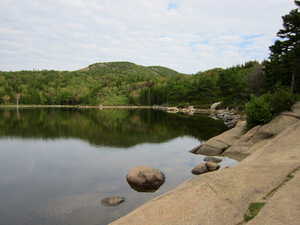
Leave a comment